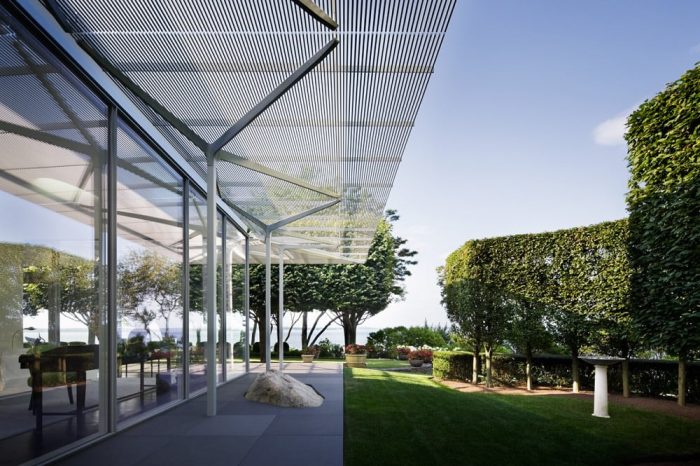蜿蜒的花园和树林中,水仙花、牡丹和萱草闪闪发光,在笔直的车道两侧。靠近小路尽头的前方是一个由苹果树组成的光圈,捕捉到了天空和水的元素:长岛海湾的地平线。当你走近时,你突然意识到你不仅仅是在看树叶,而且还在看房子。
就在灌木丛的后面,矗立着一个微妙的透明亭子。它的透光棚架–由细长的铝杆组成的水平梯形结构延伸到屋顶,与前面的树冠一致。这是与景观交织在一起的一个微妙的建筑,一个精确接地但准无重的结构,一个空灵的矩形,种植在两个现有的树林之间。像羽毛状的叶子一样,花架伸向接壤的枝叶,而亭子的内部平面–通过玻璃般的密斯式外壳完全可见–继续向外延伸,其表面的乌木竹子变成了印度黑色花岗岩的外部基座,这是一条人行道,上面的金属天棚的影子细密的条纹。
Meandering gardens and woods, sparked with daffodils, peonies and daylilies, flank the straight drive in. Up ahead near the path’s end is an aperture framed by an arbor of apple trees, capturing an elemental view of sky and water: the horizon of the Long Island Sound. As you reach closer range, you suddenly realize you have been looking not merely through foliage, but also right through the house.
Just behind the copse stands a delicately transparent pavilion. Its light-filtering trellis—a horizontal tracery of slender aluminum rods extending the roof plane—aligns with the canopy of trees before it. Woven into the landscape, this is an architecture of subtlety, a precisely grounded yet quasi-weightless structure, an ethereal rectangle, planted between two existing woods. Like feathery fronds, the trellis reaches toward the bordering leafy branches, while the pavilion’s interior floor plane—fully visible through the glassy, Miesian shell—continues outward, its surface of ebonized bamboo transformed into an exterior plinth of Indian black granite, a walkway, finely striated with shadows from the diaphanous, metal canopy above.
同时,入口轴线穿透了亭子简单的4600平方英尺的体量,切入其远侧,出现了一个长长的、奇迹般地浅的反射池,用银色的薄膜切入草坪,其远处的边缘光学地溶入声音。
在结构的透明外壳上有一条周边道路。独立的平行排列,内墙从未与围墙相遇。相反,它们形成了一个虚拟的箱中箱,一个隐含的内部容积。这些平行的平面将长长的视野引向水和花园,只允许海景的宽阔、崎岖的全景出现在房子的远方,一览无余。
Meanwhile, the entry axis penetrates the pavilion’s simple 4,600-square-foot volume, notching into its far side and emerging as a long, miraculously shallow reflecting pool, incising the lawn with a silvery film, its distant edge dissolving optically into the Sound.
A perimeter path lines the structure’s transparent shell. Freestanding in parallel alignment, the interior walls never meet the enclosure. Instead, they form a virtual box within a box, an implied inner volume. These parallel planes channel long vistas out toward water and garden, only allowing the seascape’s wide, rugged panorama to emerge in full view at the house’s far side.
这里不仅仅是一位前博物馆馆长和他妻子的单间度假屋,也是一个拥有20世纪非凡绘画、雕塑和玻璃器皿的地方–其中许多作品传达出一种浮力或漂浮感,与展馆的轻盈相呼应。艺术品总是出现在视野中,即使只是外围。相反,从花园里看,这个色彩斑斓的室内收藏品在户外也有存在感。
在景观和艺术之间生动的相互作用中,在内部和外部之间不断变化的模糊性中,该设计实现了特殊的平衡。花园中的一大片鲜艳的黄色沉香与室内的中国屏风中的金色天桥产生了共鸣;一个长满青苔的岩石花园投射到亭子的简单体积中,而卧室则依偎在花园植被的私人尖顶上。你可以在不知不觉中直视房子,但你也可以把树木的反射误认为是透过亭子的一瞥。随着天空的变化,季节性的繁荣,对话不断发展,滋养着主人在花园中生活的愿望–用艺术。
More than a one-bedroom retreat for a former museum director and his wife, this is also a place of extraordinary 20th century paintings, sculptures, and glassware—much of it conveying a sense of buoyancy or levitation that echoes the pavilion’s lightness. The artwork always figures into view out, even if only peripherally. Conversely, from the gardens, this colorful indoor collection projects a presence outdoors.
In the animated interplay between landscape and art, in the shifting ambiguities between inside and out, the design achieves exceptional balance. An arcing swath of vibrant yellow sedum in the garden resonates with the golden footbridge in a Chinese screen inside; a mossy rock garden projects into the pavilion’s simple volume, while the bedroom nestles into a private apse of garden vegetation. You can look straight through the house without realizing it, but you could also mistake reflections of trees for glimpses through the pavilion. Morphing with the skies, flourishing seasonally, the dialogue evolves, nourishing the owner’s desire to live in the garden—with art.
Architects: Thomas Phifer and Partners
Photographs : Scott Frances
City:FISHERS ISLAND
Country:UNITED STATES













